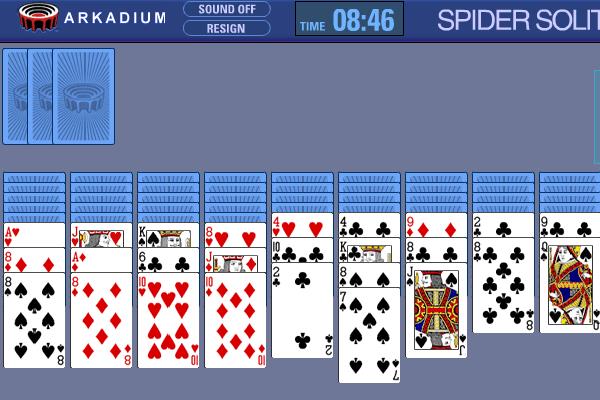

One difficult and challenging variation, Spider Solitaire, is a very popular two-deck version of the game. If you've played traditional Classic Solitaire, and looking for more of a challenge, you might want to take a look at some of the variations. A Beginner's Guide to Playing Spider Solitaire Practice in one suit mode and work your way up. Four suit Spider Solitaire is arguably the hardest Solitaire version for a player to master. Playing in four suits mode is significantly harder than playing in one suit mode. You get 100 points for each Royal Flush.The remaining 50 cards are in the Reserve, which is dealt atop the columns in the Tableau across 5 deals. Fifty four cards are dealt, with 4 columns having 6 cards each and 6 columns having 5 cards each. The playing field is organized with ten columns on the Tableau. The above games allow you to submit your high score. Tarantula - you can move sequential runs of cards on the tableau even if they are not suited.Suited runs from King down to Ace are automatically moved to a foundation.

On the tableau you can build down & move across in decending order across suits.
#Full screen spider solitaire free
We also offer multiple other versions of Spider Solitaire where you can submit your score to the high score board and see how well you rank among millions of players around the world! More Free Online Spider Solitaire Games The Undo on SpiderSolitaire.Day allows you to Undo until the most recent suit has been completed.This game saves your high score on your local computer. The method of scoring is identical in all three games. The chances of achieveing this astronomically small. The maximum possible theoretical score is 1254. The score is increased by one hundred 100 points are for each suit completed. One point is subtracted every time the Undo button is pressed. One point is subtracted for each move that you make.
#Full screen spider solitaire windows
The Scoring on SpiderSolitaire.Day is the similar to the Windows version. One card will be dealt to each column.Ĭards can only be dealt when each column contains at least one card. The card or groups of cards can be placed on any suitable card,Ĭlick on the Stock for another deal. This is the primaryĭifference between the three versions of Spider Solitaire. Only cards in suit can be moved (and split). These are placed on the Foundations automatically when complete. Ten cards are dealt at once, one to each column on the Tableau.Ĭards cannot be dealt from the Stock if any column on the Tableau is empty.īuild sets of Cards from King to Ace on the Columns in suit. There is also a Stock of cards which the player can deal. However, if the player wants to move a stack of cards, all the cards to be moved must belong to the same suit (and face up).

a Jack can be placed on a Queen, or an Ace The player can move cards, either in groups or individually, from row to row in the Tableau.Ī single card can be placed only on a card with a higher number by one, regardless of its suit, or on an empty tableau space. This is done automatically when the Tableau contains a stack of cards, arranged from King to Ace in the same suit.Īt this point the stack can be removed from play and placed on a foundation. The primary difference from other solitaires, is that in Spider Solitaire the playerĭoes not place the cards directly on the foundations. The more suits, the harder it is to sort the cards. This is where the levels of difficuly arise. As in other solitaires, the aim is to sort the shuffled cards by number and by suit.


 0 kommentar(er)
0 kommentar(er)
